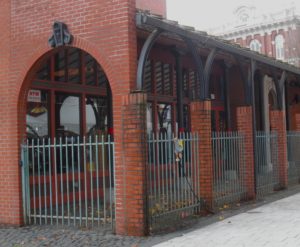
Portland cast iron over your head in an earthquake? It’s still art.
I see the stuff and think health hazard.
Cast iron is heavy enough on the ground, let alone falling any distance.
That’s one of the cautions about historic preservation: save yourself first.
Portland is home to the second largest collection of cast-iron architecture in the United States, just behind New York City’s historic Soho District. Cast-iron-fronted buildings were constructed in Portland between the 1850s and 1880s, with a large concentration along the west-side waterfront.
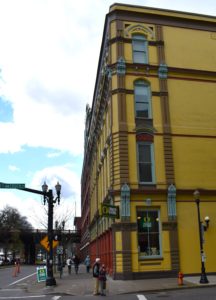
The Oregon Duck store right on NW Front with enough cast iron to rebuild the Battleship Oregon.
Cast iron was new back then. You might wonder if the buildings were supposed to last.
Pre-fabricated iron pieces allowed buildings to be constructed more quickly with less labor and fewer costs.
What are the chances the buildings were warehouses feeding the ships tied up at the docks?
Portland cast iron on the outside

The seven cast iron columns painted white stand near Saturday Market.
Bolted to steel beams anchored in concrete, these provide no threat of falling.
In the 1980’s I worked for a company charged with storing Portland cast iron architecture pieces.
Walking through a barn, from a public to private area, I found baking racks full of plaster molds used for cast iron.
While I didn’t expect bread on the bread racks, I didn’t expect such a load of plaster.
But still no cast iron.
Another set of sliding doors opened to a fenced in storage lot behind the barn.
The black berries bushes grew up the cyclone fence and covered the ground shoulder high.
It was a black berry patch.
The man beside me called it cast iron storage.
“It’s full of black berries.”
“They’ll cut you too.”
“Cast iron black berries?”
“That’s underneath the black berries.”
“How much?”
“A lot.”
Cast iron became so popular in Portland that 90 percent of commercial buildings used the material in their construction between 1854 and 1889.
Digging cast iron
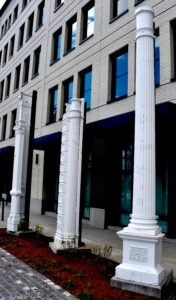
We spent the next week cutting black berry vines.
Rusted metal finally showed through the brambles.
Some had sunk into the ground on rotted stickers.
Using the tricks of the trade, we consolidated the plaster inside the barn to clear space, gathered up dollies, built a plywood highway from the yard to the barn door, and started moving and cleaning.
“How long has this stuff been laying out here?”
“You’re looking at the rust. Rust protects the metal.”
“How does that work?”
“If you cleaned all the rust off one of these cast iron pieces and put it back down, what happens?”
“It rusts again.”
“Exactly, and rusting up again removes even more material. So rust once, not twice.”
“Okay. And how long?”
“Maybe the Seventies.”
Delicate cast iron
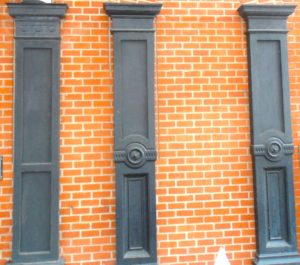
Many of the early cast-iron buildings followed similar design aesthetics. The main elements were decorated front pilasters, ranging from ten to fifteen feet in height, with Corinthian capitals.
We dry cleaned with soft brushes, rolled them onto dollies, and parked them inside off the floor on new wooden stickers.
They looked the same as they did outside, just without the black berries.
Impervious to the elements and looking for a big comeback in popularity, they wait.
In 1873, a fire spread through Portland, destroying nearly all of the city’s cast-iron buildings in its wake. Two buildings on Southwest First Avenue were rebuilt with their original columns—the 1865 Pearne Building, a collaboration between Absalom Hallock and Elwood Burton, and the 1867 Poppleton Building. Both structures are city landmarks.
The lost opportunity
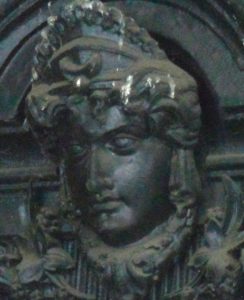
Today we’re used to glass and steel buildings.
They decorate American skylines in stripes of modern design.
“Oh, let’s do something in stripes,” you might hear in Portland.
After Michael Graves’ Portland building, stripes probably sounded like a good idea.
But there’s still that other group interested in more than striped architecture.
Many of the cast-iron buildings were demolished during the 1940s and 1950s, as structures were razed in the name of progress and parking lots. The construction of more modern office buildings as well as the Morrison Bridge led to further demolitions. After the wrecking ball, only a few buildings remained in a city once dominated by cast-iron architecture.
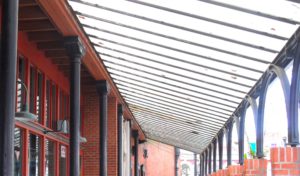
Fred Leeson from chatterbox says:
Portland had the second largest collection of cast iron buildings on the West Coast, mostly Italianate in design, that lined Front, First and Second Avenues. Many remained intact until after World War II, when many were torn down to make way for surface parking. If Portland had exercised better sense at the time, those cast-iron streets today likely would be a prime tourist magnet of the West Coast.
Cast iron streets and prime tourist magnet of the West Coast sounds like a good match.
Rushing to modern times leaves so much behind, the same as reverting to the past without thoughtful consideration.
What got left out today?


